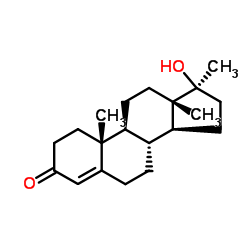17-Methyltestosterone

17-Methyltestosterone structure
|
Common Name | 17-Methyltestosterone | ||
|---|---|---|---|---|
| CAS Number | 58-18-4 | Molecular Weight | 302.451 | |
| Density | 1.1±0.1 g/cm3 | Boiling Point | 434.4±45.0 °C at 760 mmHg | |
| Molecular Formula | C20H30O2 | Melting Point | 162-168 °C(lit.) | |
| MSDS | Chinese USA | Flash Point | 185.3±21.3 °C | |
| Symbol |

GHS08 |
Signal Word | Danger | |
|
Study on the phase I metabolism of novel synthetic cannabinoids, APICA and its fluorinated analogue.
Drug Test. Anal. 7(2) , 131-42, (2015) The data are reported for an in vitro metabolism study of two novel synthetic cannabinoids, N-(1-adamantyl)-1-pentyl-1H-indole-3-carboxamide (APICA) and its fluorinated analog N-(1-adamantyl)-1-(5-fluoropentyl)-1H-indole-3-carboxamide (5F-APICA, STS-135), whi... |
|
|
Cheminformatics analysis of assertions mined from literature that describe drug-induced liver injury in different species.
Chem. Res. Toxicol. 23 , 171-83, (2010) Drug-induced liver injury is one of the main causes of drug attrition. The ability to predict the liver effects of drug candidates from their chemical structures is critical to help guide experimental drug discovery projects toward safer medicines. In this st... |
|
|
Translating clinical findings into knowledge in drug safety evaluation--drug induced liver injury prediction system (DILIps).
J. Sci. Ind. Res. 65(10) , 808, (2006) Drug-induced liver injury (DILI) is a significant concern in drug development due to the poor concordance between preclinical and clinical findings of liver toxicity. We hypothesized that the DILI types (hepatotoxic side effects) seen in the clinic can be tra... |
|
|
The Japanese toxicogenomics project: application of toxicogenomics.
Mol. Nutr. Food. Res. 54 , 218-27, (2010) Biotechnology advances have provided novel methods for the risk assessment of chemicals. The application of microarray technologies to toxicology, known as toxicogenomics, is becoming an accepted approach for identifying chemicals with potential safety proble... |
|
|
Screening for anabolic steroids in sports: analytical strategy based on the detection of phase I and phase II intact urinary metabolites by liquid chromatography tandem mass spectrometry.
J. Chromatogr. A. 1389 , 65-75, (2015) In order to improve the detection capabilities of anabolic androgenic steroids (AAS) in sports, a liquid chromatography-tandem mass spectrometry (LC-MS/MS) screening method for the simultaneous detection of AAS phase I and phase II intact urinary metabolites ... |
|
|
An updated steroid benchmark set and its application in the discovery of novel nanomolar ligands of sex hormone-binding globulin.
J. Med. Chem. 51 , 2047-56, (2008) A benchmark data set of steroids with known affinity for sex hormone-binding globulin (SHBG) has been widely used to validate popular molecular field-based QSAR techniques. We have expanded the data set by adding a number of nonsteroidal SHBG ligands identifi... |
|
|
Impact of induced fit on ligand binding to the androgen receptor: a multidimensional QSAR study to predict endocrine-disrupting effects of environmental chemicals.
J. Med. Chem. 48 , 5666-74, (2005) We investigated the influence of induced fit of the androgen receptor binding pocket on free energies of ligand binding. On the basis of a novel alignment procedure using flexible docking, molecular dynamics simulations, and linear-interaction energy analysis... |
|
|
The Development and Single-Laboratory Validation of a Method for the Determination of Steroid Residues in Fish and Fish Products.
J. AOAC Int. 98 , 580-7, (2015) Due to potential use in aquacultured fish products, the Canadian Food Inspection Agency has identified residue testing for steroids as a priority. These compounds are used in aquaculture primarily to direct sexual differentiation with both androgens and estro... |
|
|
Screening for anabolic steroids in urine of forensic cases using fully automated solid phase extraction and LC-MS-MS.
J. Anal. Toxicol. 38(9) , 637-44, (2014) A screening method for 18 frequently measured exogenous anabolic steroids and the testosterone/epitestosterone (T/E) ratio in forensic cases has been developed and validated. The method involves a fully automated sample preparation including enzyme treatment,... |
|
|
Imitation of phase I oxidative metabolism of anabolic steroids by titanium dioxide photocatalysis.
Eur. J. Pharm. Sci. 65 , 45-55, (2014) The aim of this study was to investigate the feasibility of titanium dioxide (TiO2) photocatalysis for oxidation of anabolic steroids and for imitation of their phase I metabolism. The photocatalytic reaction products of five anabolic steroids were compared t... |